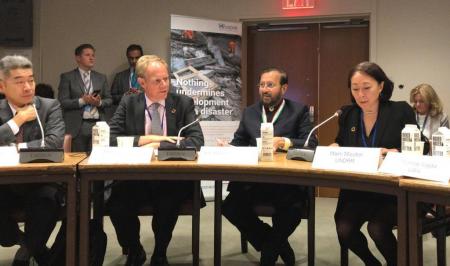
Prakash Javadekar, India’s Minister for Environment and Climate Change (centre), Matthew Rycroft, permanent Secretary for the UK Department for International Development (left) and Mami Mizutori, Head of the UN Office for Disaster Risk Reduction at the coalition event in New York.
By Omar Amach and Jeanette Elsworth
NEW YORK, 25 September 2019 – The UK, Japan and Bhutan announced that they have joined the Coalition for Disaster Resilient Infrastructure, following its launch this week by the Prime Minister of India, Narendra Modi.
Speaking at an event in the sidelines of the high-level meetings in New York, Prakash Javadekar, India’s Minister for Environment and Climate Change, stressed the need for collaboration and cooperation at the heart of the initiative.
“It is important that this initiative is seen as an initiative that brings together developed and the developing countries, small island states, landlocked countries, countries with advanced infrastructure systems, and countries with large infrastructure deficits. In doing so we must actively seek to build synergies with the ongoing initiatives, whether it is the work of the World Bank on the Lifelines report, the work of the Global Commission on Adaptation, or the work of the Insurance Development Forum,” said Mr. Javadekar.
Over the next twenty years, an estimated $94 trillion US Dollars will need to be invested in infrastructure to meet growth, and 60% of this investment will take place in developing countries. The impact of disasters on infrastructure manifests itself either as the outright destruction of an infrastructure asset due to a high-intensity disaster event, or the gradual degradation of assets over successive medium or low-intensity events.
The poor typically bear the worst brunt of such events as they often lack adequate resources for coping with disasters. Thus, the downstream effects of the loss and damage to infrastructure may be felt for years after the disaster, including through its cascading impact and service disruptions.